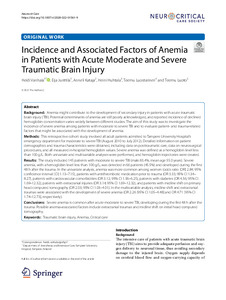Incidence and Associated Factors of Anemia in Patients with Acute Moderate and Severe Traumatic Brain Injury
Vanhala, Heidi; Junttila, Eija; Kataja, Anneli; Huhtala, Heini; Luostarinen, Teemu; Luoto, Teemu (2022)
Vanhala, Heidi
Junttila, Eija
Kataja, Anneli
Huhtala, Heini
Luostarinen, Teemu
Luoto, Teemu
2022
Julkaisun pysyvä osoite on
https://urn.fi/URN:NBN:fi:tuni-202208186519
https://urn.fi/URN:NBN:fi:tuni-202208186519
Kuvaus
Peer reviewed
Tiivistelmä
Background: Anemia might contribute to the development of secondary injury in patients with acute traumatic brain injury (TBI). Potential determinants of anemia are still poorly acknowledged, and reported incidence of declined hemoglobin concentration varies widely between different studies. The aim of this study was to investigate the incidence of severe anemia among patients with moderate to severe TBI and to evaluate patient- and trauma-related factors that might be associated with the development of anemia. Methods: This retrospective cohort study involved all adult patients admitted to Tampere University Hospital’s emergency department for moderate to severe TBI (August 2010 to July 2012). Detailed information on patient demographics and trauma characteristics were obtained, including data on posttraumatic care, data on neurosurgical procedures, and all measured in-hospital hemoglobin values. Severe anemia was defined as a hemoglobin level less than 100 g/L. Both univariate and multivariable analyses were performed, and hemoglobin trajectories were created. Results: The study included 145 patients with moderate to severe TBI (male 83.4%, mean age 55.0 years). Severe anemia, with a hemoglobin level less than 100 g/L, was detected in 66 patients (45.5%) and developed during the first 48 h after the trauma. In the univariate analysis, anemia was more common among women (odds ratio [OR] 2.84; 95% confidence interval [CI] 1.13–7.15), patients with antithrombotic medication prior to trauma (OR 3.33; 95% CI 1.34–8.27), patients with cardiovascular comorbidities (OR 3.12; 95% CI 1.56–6.25), patients with diabetes (OR 4.56; 95% CI 1.69–12.32), patients with extracranial injuries (OR 3.14; 95% CI 1.69–12.32), and patients with midline shift on primary head computed tomography (OR 2.03; 95% CI 1.03–4.01). In the multivariable analysis, midline shift and extracranial traumas were associated with the development of severe anemia (OR 2.26 [95% CI 1.05–4.48] and OR 4.71 [95% CI 1.74–12.73], respectively). Conclusions: Severe anemia is common after acute moderate to severe TBI, developing during the first 48 h after the trauma. Possible anemia-associated factors include extracranial traumas and midline shift on initial head computed tomography.
Kokoelmat
- TUNICRIS-julkaisut [16929]
